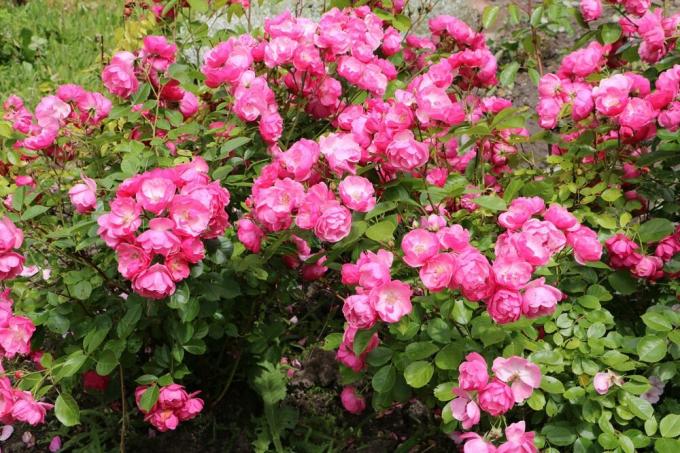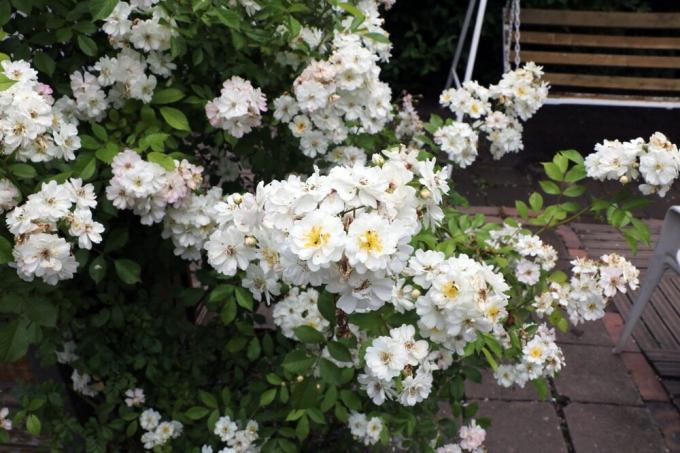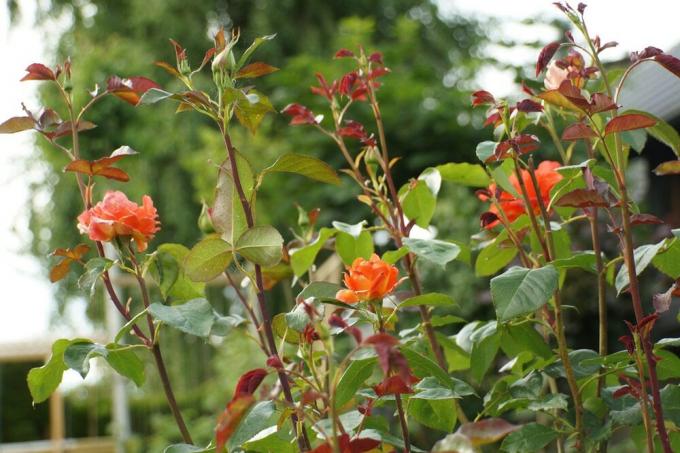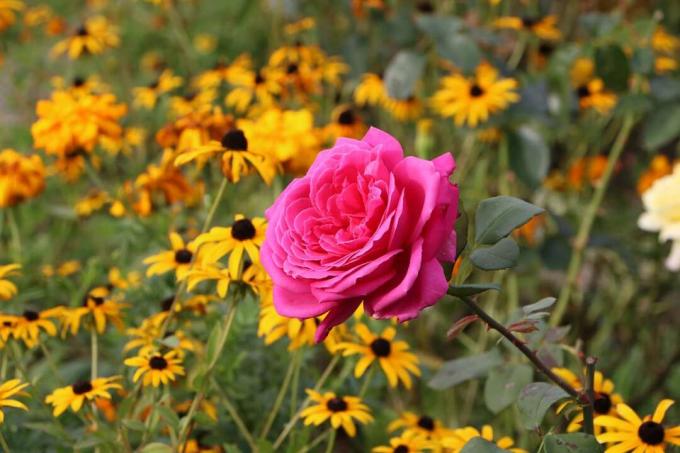

Table of contents
- cuts and cutting purposes
- The education cut
- The plant cut
- The basic cut
- The best time for the basic cut
- Flowerbed pruning in detail
- Cut standard roses
The cut represents the most important care of a bed rose. Not difficult to see - you basically shape the wood with the cut and also take care of it with the cut for the luxuriant bloom, the pruning is natural for the beauty of the very bed roses important. With the cut, you also ensure that the floribunda can nourish itself well and grow so airy and that fungi don't stand a chance, so pruning is also fundamentally important for the health of the Plant. There is just one thing the cut is not: So complicated that you would have to shy away from cutting, as the following instructions show:
cuts and cutting purposes
- Small bed roses are formed into a pleasing growth habit through training pruning
- Before planting, young plants may need a plant cutting
- Both cuts usually get sales plants in the nursery
- In the case of roses you have grown yourself, you are responsible for these pruning measures
- In the long run, bed roses only remain thriving if they are trimmed regularly
- Even the compact growth form gradually falls apart without pruning
- The basic cut is pretty straightforward:
- Cut back all new side shoots to the desired extent
- Follow the guidelines of the training pattern
- Damaged wood is also removed (throughout the season)
- All this also applies to standard roses, just a little attention when shaping the crown
The education cut
Suppose you are dealing with a rose bush that you have been tending since the seed has developed into a seedling or a cutting has developed roots and the first leaves/shoots.
Then you are responsible for the pruning of the young rose, depending on the planned shape:
- If the rose is to grow in a normal bush form, a framework of main branches is formed
- Strong twigs that are suitable in terms of shape and position are left standing
- They are freed from competition as far as possible and necessary so that they can develop vigorously
- At the base, all but the appropriate shoots are cut away
- The shoots that continue the basic structure in the right direction are allowed to continue growing from the branches that appear later
- This means that all shoots that grow too close to the main branches must first give way
- They "steal" nutrients from the leading branches and would compress the stick inside
- However, trees and shrubs should have a loose structure inside, because fungi love dense, moist plant matter
- In addition, shoots are removed that grow unconventionally (crooked, twisted, etc.) or weakly
- More has to be done if the rose bush is to be pulled to the (real) standard
- Then a trunk with a crown must first be built
- The trunk is created by choosing a strong shoot as the trunk, from which any lateral outgrowth is immediately removed
- The keyword for success is immediate, every stem shoot that is nourished longer makes the stem become a little thinner
- With this method, a high trunk is created, the height of which is created in the growth habit of the rose
Tip:
With this training cut you set the basic shape and direction. While in the trade standard shrub forms are grown, you have it in your hands to form a particularly wide branching or a very narrow rose bush.
The plant cut
If you have purchased a young floribunda, the rose bush may need pruning prior to planting. This occurs when the ratio of root mass and plant mass in the upper area is not correct. When huge root masses are supposed to feed three leaves at the top, the nutrients that are not being used lead to a kind of metabolic congestion; when large masses of plants grow on tiny roots, the plant cannot keep up with the supply.

The gardener with decades of experience can achieve the best training pruning and the best correction of the "root-shoot-ratio" (ratio of roots to shoots and leaves). Because this is the case, the young plants in the mass trade have already undergone pruning and pruning and can be planted as they are. Normally you won't get roses growing on their own roots here anyway, but cultivated varieties grafted onto robust wild rose rootstock. Which develop a special root-shoot-ratio and as a standard not according to plant specifications, but according to Dealer specification can be drawn (what the half, quarter, three-quarter and whatever else is offered explained).
If you buy bare-root roses that are not planted freshly harvested, a gentle pruning is recommended, even if the main part has already been done by the retailer. It's all about removing dried root ends so the roots can absorb water and nutrients. If you buy from a specialist retailer, they will usually tell you exactly what cuts the rose needs now and in the future.
The basic cut
Once the rose has been planted and has taken root in your garden, it is given a "heavy pruning" once a year. This basic cut of a bed rose is not very complicated, the following points must be observed:
- The framework of supporting branches formed with the training pruning sets the direction
- These guidelines are followed
- All new side shoots are pruned all around to the desired extent
- In addition, dead, crooked, rotten, broken wood is removed
- This can happen throughout the season
The best time for the basic cut
The best time to prune a floribunda depends on when and how often its flowers appear. Since the influences of all possible ancestors are noticeable in bed roses, there are a few variants when it comes to flowering:
- There are bed roses that only bloom once a year – for a more or less long time
- These bed roses are pruned after flowering
- If the rose is to remain as it is, all fresh side shoots are cut down except for a few eyes
- If the rose is to gain height, a few more eyes remain
- If the rose is already too tall, almost all of the new growth is cut away
- Old wood has to gradually give way here so that new construction can take place from below
- This rejuvenation pruning is applied in the spring before budding
- Can be spread over 2 years depending on the constitution of the rose (heavy summer pruning weakens the plant)
- If a rose flowers continuously or several times, it gets its basic pruning in spring
- In most German regions, late February/March is the best time
- In very cold regions, scissors are not used until the end of March/April
- Pruning takes place when the severe frosts are over and the roses are about to start sprouting
- Weak and old shoots are removed completely, diseased shoots later in the season as well
- The more roses are cut back during the rest period, the more budding is encouraged
- Carefully cut back vigorous varieties at this time
- Motivate hesitantly growing varieties with vigorous pruning
- If a rose grows too dense on the inside, it is also thinned out during the basic cut
- The overall structure of the stick should be air-permeable on the inside
- If the stock has wood that hardly blooms after two or three years, it needs to be rejuvenated
- To do this, the lazy old shoots are completely cut out of the stick, from below
- If wild shoots emerge from the rootstock, they are treated as described below for standard roses
Tip:
If your floribunda blooms a lot and for a long time and you don't have the sales information about the flower, you might want to know how the flowering of this cultivar is described in the technical information. You can find that out from the name of the cultivar on the internet; the typical buzzwords have the following meaning: "Permanently blooming" means that a rose was trained to constantly push buds. "Frequently blooming" roses bloom in spurts and then take a break, while bed roses with a strong bloom become "reblooming". Called the main bloom and (smaller, isolated) secondary blooms (which sometimes fail completely in less than optimal locations). can). Incidentally, bed roses should not always adhere to what is written in the sales description.
Flowerbed pruning in detail
"One-time flowering, continuous flowering, repeated flowering, reblooming" has an effect on the flowering and growth potential of the rose bush and thus also on the intensity of the pruning.
If your floribunda only flowers once a year like a hybrid tea rose, there won't be much to prune in the first few years. Even later, such bed roses do not necessarily have to be trimmed all around every year. You must also cut these bed roses regularly so that the flowering power is maintained. However, you can only take on a few branches each year, and every second or third season you should have caught every branch of the rose.
Multi-flowering and continuously flowering bed roses that are cut back in the spring need more pruning, and that every year. If you don't give them this pruning, the rose bushes will tend to fall apart and flowering will fade. Usually about two-thirds of the total height is taken away with the cut. But there are slower-growing bed roses for which this is not necessary, and in their obviously optimal locations it is almost rampant bed roses that need to be cut back a little more and maybe again in autumn.

Once they have bloomed, the faded flowers can also be cut away with the basic pruning. If there was a remontante among the ancestors, there may be another flowering. If you see a lot of flowers, cutting away the faded flowers is part of your program anyway want: If you prevent roses from forming seeds (producing offspring) by cutting away the faded flowers, they will always develop a second bloom when it is part of their genetic program and the time until winter still allows it might.
Tip:
You can leave the last bloom of a bed rose in the current season and let it mature into rose hips. The fruits, which ripen from mid-September, should be harvested as soon as they are ripe if they are to be processed into mush and/or jam. If the rose hips are to be eaten raw, you should wait patiently until the first frost has covered the plants. The frost makes the rose hips softer and sweeter, and in this state they can be harvested until February. The fruit stalk stays on the plant as winter protection, its remains are removed when the rose gets its basic pruning.
Cut standard roses
The standard tree that you grow yourself or that you buy ready-made is basically cut in the same way as described above. Only in the shape of course a little different, the crown of the standard should usually grow rather rounded.
Here you only have to make sure (even during the season) that you use the usually refined ones Standard trees consistently remove all side shoots below the grafting point or in the upper area appear. If you remove a wild shoot too late, it may steal a few nutrients from the graft. If you simply let many wild shoots grow, it can happen that your very special cultivar completely reverts to the wild form.
Wild shoots should not be cut off, this only promotes increased wild sprouting. Rather, they should be torn down, if possible below the grafting point in the ground.
 garden editorial
garden editorial I write about everything that interests me in my garden.
Learn more about roses

What goes with roses: 30 beautiful rose companions
The beauty of roses really comes into its own when surrounded by the right companion plants. It is important for rose companions that they have similar requirements to roses. We tell you what goes well with roses.

Rose soil: mix soil for roses yourself | composition
The rose is considered the queen of flowers and she is very demanding. When it is newly planted, the soil should therefore be optimally prepared. Special rose soils are particularly suitable for planting. How to make them yourself is in this post.

Rose cuttings: 8 tips for propagating roses
Roses can be propagated quite easily with the help of cuttings if the site conditions and the preparation are right. Both the time and the care play an important role in ensuring that the rose shoot takes root successfully and then thrives magnificently.

Combat rose pests | 10 typical pests on roses
Roses are the pride of many ornamental gardens. But in addition to diseases, pests also give you trouble again and again. Anyone who knows how to recognize and fight them can easily and quickly protect their darlings from most dangers.

Rose care in spring | 5 tips for the new season
The rose, the queen of flowers, should not be missing in any garden! If you want to enjoy the blooming splendor of bedding, hedge and climbing roses in summer, you have to start caring for the roses in spring. We have put together the most important information for you.

Caterpillars and Bugs on Roses: Spotting 16 Common Pests
Roses, the queen of flowers, impress with a variety of species and varieties. Their care is easy to difficult. This is in the eye of the beholder. However, care mistakes are only a danger for roses, because they are also popular with numerous pests.
